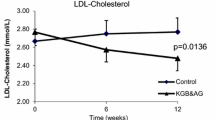Abstract
The effect of dry Sundakai powder supplementation (7 g providing 1.23 g of crude fibre) on glycemic control, lipidemic control, total amino acids and uronic acid was studied on 30 non-insulin dependent diabetes mellitus patients. All the patients were on hypoglycemic drugs. The above parameters were monitored at day 1, 15 and 30 days. After one month of fibre supplementation, no significant changes were observed with respect to glucose, lipid profile, glycated proteins, total amino acids and uronic acid levels in these subjects.
Similar content being viewed by others
References
Ahuja MMS (1984) Prevalence of diabetes mellitus, in Practice of Diabetes Mellitus in India. Vikas Publication House Pvt Ltd, Delhi, p 45
Mani I, Patel JJ and Mani UV (1987) Effect of wheat bran supplementation on serum lipids and urinary imino acids in maturity onset diabetics. J Clin Biochem and Nutr 3: 143
Mani I, Patel JJ and Mani UV (1987) Measurement of serum glycosylated protein and glycosylated low density lipoprotein fraction in the serum of diabetics. Biochem Med 37: 184–189
Savage PJ and Knowler WC (1984) Diet therapy for type II (Non-Insulin Dependent Diabetes Mellitus). Can new approaches improve therapeutic results? Reviews in Clinical Nutrition 54: 71–87
Story L, Anderson JW, Chen JWL, Karouns D and Jefferson BW (1985) Adherence to high carbohydrate high fibre diets. Long term studies on non-obese diabetic men. The American Diabetic Association 85: 1105–1110
Munoz JM (1984) Fibre and Diabetes. Diabetes Care 7: 297–300
Bernard RJ, Massey MR, Chenney S, O'Brian LT and Pritein N (1983) Long term use of high complex carbohydrate high fibre low fat diet and exercise in the treatment of NIDDM patients. Diabetes Care 6: 268–272.
Goswamy S, Mani I and Mani UV (1985) Effect of wheat bran supplementation of tissue lipids in diabetic rats. Ind J Biochem Biophys 22: 240–243
Mani I and Mani UV (1987) Effect of wheat bran supplementation on blood sugar, glycosylated protein and serum lipids in NIDDM patients. Plant Foods for Human Nutrition 37: 161–168
Mani I, Patel JJ and Mani UV (1987) Studies on the effect of wheat bran fibre on serum and urinary amino acids and imino acids in non-insulin dependent diabetic patients. J Clin Biochem Nutr, 3: 143–148
Mani UV, Sharma M, Waghray K, Iyer U and Mani I (1989) Effect of colocasia leaves on serum and tissue lipids in cholesterol fed rats. Plant Foods for Human Nutrition 39: 245–255
Iyer UM and Mani UV (1990) Studies on the effect of curry leaves powder supplementation on lipid profile, glycated proteins and amino acids in non-insulin dependent diabetic patients. Plant Foods for Human Nutrition 40: 275
Gopalan C, Rama-Sastri BV and Balasubramanian SC (1989) Revised and updated by Narasingha Rao Bs, Deosthale YG and Pant KC. Nutritive value of Indian foods. National Institute of Nutrition, Indian Council of Medical Research, Hyderabad, India
CSIR diagnostic kit for blood sugar (1959) Method of Hultman E, Nature (London) 183: 108–109
Christopher K, Frings CS, Fendly W, Dunn RT and Queen CA (1972) Improved determination of total serum lipids by the sulpho-phospho vanillin reaction. Clin Chem 18: 673–674
Foster LB and Dunn RJ (1973) Stable reagents for the determination of serum triglycerides by a Colorimetric Hantzach Condensation method. Clin Chem 19: 338–346
Bitter T and Muir H (1962) A modified uronic acid carbazole reaction. Annal Biochem 4: 330–335
Rosen H (1957) Modified Ninhydrin Colorimetric analysis for amino acids. Arch Biochem Biophys 67: 10–15
Ranbaxy Diagnostic Enzymatic Kit for total cholesterol using CHOD-PAP method. Supplied by Ranbaxy Company, India
Warnick GR, Mayfield CB, Benderson JBS, Chen JS and Albert JJ (1982) HDL-cholesterol quantification by phosphotungstate Mg+2 polyethylene glycol precipitation. Both with enzymic cholesterol assay compared with the lipid research method. Am J Clin Pathol 78: 718–722
Weiland H and Seidel D (1983) A simple specific method for precipitation of low density lipoprotein. J Lipid Res 24: 904–908
Author information
Authors and Affiliations
Rights and permissions
About this article
Cite this article
Iyer, U.M., Mehta, N.C., Mani, I. et al. Studies on the effect of dry Sundakai (solanum torvum) powder supplementation on lipid profile, glycated proteins and amino acids in non-insulin dependent diabetic patients. Plant Food Hum Nutr 42, 175–182 (1992). https://doi.org/10.1007/BF02196470
Received:
Accepted:
Issue Date:
DOI: https://doi.org/10.1007/BF02196470




